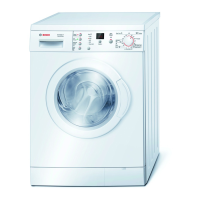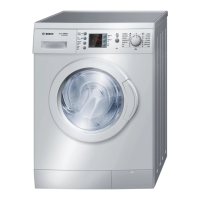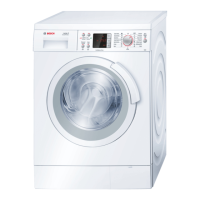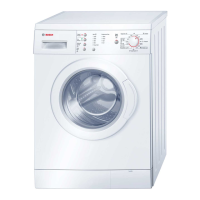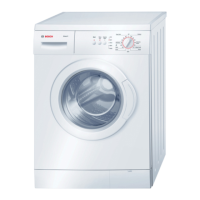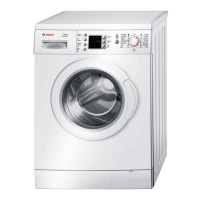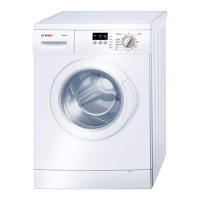7
Overview of programmes a refer to the table of consumption values o n page 8 and notes on page 6.
Programmes °C max.
Type of laundry
Additional functions; information
L Cottons 30, 40, 60, 90 °C
6 kg/
4 kg*
Hard-wearing fabrics, heat-resistan t fabrics made of
cotton or linen
Ĉ÷Speed Perfect*, ć Eco Perfect, S Reduce d Ironing,
= Aqua Plus
+ 7 Prewash 40 °C
I Easy-Care 30, 40, 60 °C
3 kg
Easy-care fabrics made of cotton, linen , synthetic
fibres or blended fabrics
Ĉ÷Speed Perfect, ć Eco Perfect, S Reduced Ir oning,
= Aqua Plus
/ Mixed Load
40 °C Fabrics made of cotton or easy-care f abrics
Ĉ÷Speed Perfect, ć Eco Perfect, S Reduced Ir oning,
= Aqua Plus;
different types of laundry can be washed togeth er
Delicate/Silk 30 °C
2 kg
For delicate, washable fabrics, e.g. made of silk, satin,
synthetic fibres or blended fabrics (e.g . curtains)
Ĉ÷Speed Perfect, ć Eco Perfect, S Reduced Ir oning,
= Aqua Plus;
No spin between rinse cycles
: / Wool cold, 30 °C
Handä or machine-washable fabrics mad e of wool or
containing wool
Particularly gentle wash programme to prevent sh rinkage of
laundry. Longer programme breaks (fabrics rest in the detergent
solution)
@SuperQuick 15’ 30 °C
Easy-care fabrics made of cotton, linen , synthetic
fibres or blended fabrics
Short programme, approx. 15 minutes,
suitable for lightly soiled laundry
Additional programmes 2 Rinse/ Spin, > Drain
* Reduced load for additional Ĉ÷SpeedPer fect function
As a short programme, / Mixed Load 40 °C, with a m aximum spin speed, is ideal.
Programmes without prewash - add deterg ent to compartment II, programmes with prewash - distribute the detergent between co mpartments I and II.
9209 / 9000777144
*777144*
WAE24166UK ...
Robert Bosch Hausgeräte GmbH
Carl-Wery-Str. 34
81739 München / Deutschland
8
Safety instructions
– Read the instruction manual and installation instructions and all other information enclosed
with the washing machine and act a ccordingly.
– Retain the documents for s ubsequent use.
Risk of electric shock – Never pull the cable to disconnect the mains plug.
– Never insert/disconnect the mains plug with damp hands.
Danger to life For worn-out appliances:
– Disconnect the mains p lug.
– Sever the mains cable and discard along with the plug.
– Destroy the lock on the washing mac hine door. This will prevent
children from locking themselves i n and risking their lives.
Danger of suffocation – Keep packaging, film and packaging parts out of the reach of
children.
Risk of poisoning – Keep detergents and care products out of the reach of chil dren.
Risk of explosion – Items of laundry pretreated with cleaning agents containing
solvents, e.g. stain remover/clean ing solvent may cause an
explosion after being loaded into th e washing machine.
Rinse items of laundry thoroughly by hand beforehand.
Risk of injury – The wa shing machine door can become ver y hot.
– Be careful when draini ng hot detergent solution.
– Do not climb onto the washi ng machine.
– Do not lean on the open wa shing machine door.
– Do not reach into the drum if it is still rotating.
– Be careful when opening the detergent drawer while the machine
is in operation.
Consumption values depending on model
Programme Load Electricity*** Water***
Programme
duration
***
LCottons 30 °C* 6 kg 0,51 kWh 55 l 02:22 h
LCottons 40 °C* 6 kg 0,63 kWh 55 l 02:22 h
LCottons60 °C* 6 kg 1,26 kWh 55 l 02:31 h
LCottons 90 °C 6 kg 1,98 kWh 59 l 02:35 h
Easy-Care 40 °C* 3 kg 0,55 kWh 55 l 01:37 h
/ Mixed Load 40 °C
3 kg 0,48 kWh 32 l 01:03 h
cDelicate/Silk 30 °C 2 kg 0,21 kWh 31 l 00:41 h
:ü/ Wool 30 °C 2 kg 0,19 kWh 39 l 00:40 h
* Programme setting for testing in accordance with va lid standard EN60456.
Note on comparative tests: For testing the test prog rammes, wash the specified load using the maximum spin speed.
Programme Additional function Load
Annual energy
consumption
Annual water
consumption
LCottons40/60 °C ćEcoPerfect** 6/3kg 196 kWh 10120 l
** Programme s etting for testing and energy labelling in accordance with EU directive 2010/30 /EU with cold water (15 ºC).
*** The values deviate from the indicated values depending on wa ter pressure, hardness, and inlet temperature, ambient tem-
perature, type, amount and soiling of the laun dry, detergent used, fluctuations in the power supply and selected additional
functions.
9
Care
Before washing for the first time
Do not load any laundry into the m achine. Turn on the tap.
Add the following to compartme nt II:
– approx. 1 litre water
– detergent (dosage according to the manufacturer's instruction s for light soiling and the
appropriate degree of water hardness)
Set the programme selector to I Eas y-Care 60 °C and select ÷Start. At th e end of the
programme, turn the programme selector to Off.
Machine housing, control panel
– Wipe with a soft, dam p cloth.
– Do not use any abrasiv e cloths, scourers or cleaning agents ( stainless steel cleaners).
– Remove detergent an d cleaning agent residue immediatel y.
– Do not clean with a je t of water.
Cleaning the detergent drawer and housing...
... if it contains detergent or fabric softener residues.
1. P ull the drawer out, press down the insert and fully remove the draw er
from the housing.
2. T o remove the insert: press the inse rt upwards from below with your
finger.
3. C lean the detergent dispenser tray and insert with water and a brush and
dry it. Also remove any deterge nt or fabric softener residues in the
housing.
4. A ttach the insert and engage (con nect the cylinder to the guide pin).
5. P ush in the detergent drawer.
Leave the detergent drawer open so that any residual water can
evaporate.
Washing drum and rubber seal
Wipe the inside of the rubber seal dry with a cloth. Leave the washing machine door open so
that the drum can dry out. Rust s tains - use chlorine-free cleaning agent, not steel wool.
Descaling Ensure there is no lau ndry in the machine
Descale the appliance according to the descaler manufacturer's instructions. This should not
be necessary if the correct dosage o f detergent is used.
Information on the indicator lights model-dependent
A signal sounds and indicator lights for the spin speed flash:
¤
¤
¤
¤
¤
Close the washing
machine door properly;
laundry may be caught.
¤
¤
¤
¤
¤
Detergent solution pump
blocked; Clean the
detergent solution pump
a page 10.
Drainage hose/waste pipe
blocked; Clean the drainage
hose at the siphon
a page 10.
¤
¤
¤
¤
¤
Open the tap completely,
supply hose kinked or
trapped;
Clean the filter
a page 10,
Water pressure too low.
¤
¤
¤
¤
¤
Motor fault. Call the after-
sales service.
¤
¤
¤
¤
¤
Water in the base tub,
appliance leaking. Call the
after-sales service.
– Risk of electric shock. Dis connect the mains plug.
– Risk of explosion. No solv ents.
10
Maintenance
Detergent solution pump
Turn the programme selector to Off and di sconnect the mains plug.
1. O pen and remove the service flap.
2. F or models with a drainage hose: Remove the drainage hose from the retainer and pull it
from the housing. Remove the containe r.
Remove the sealing cap, allow the detergent s olution to flow out.
Replace the sealing cap and place th e drainage hose in the retainer.
2* For models without a drainage hos e: Carefully unscrew the pump co ver until the
detergent solution begins to flow out. When the service flap is half full, close the pump cover
and empty the service flap. Repeat the abov e steps until all the detergent solution has
completely drained out.
3. C arefully unscrew the pump cover (residual water).
4. C lean the interior, pump cover thread and pump housing (the impeller in the detergent
solution pump must rotate).
5. R eplace the pump cover and screw it tightly in place.
6. P lace the service flap back on and close.
To prevent unused detergent from flowing str aight into the drain during the next wash: pour 1 litre of water into
compartment II and start the >Drain programme.
Drainage hos e at the siphon
Turn the programme selector to Off and di sconnect the mains plug.
1. L oosen the hose clamp, carefully remove the drainage hose (residual water).
2. C lean the drainage hose and siphon connecting piece.
3. R eattach the drainage hose and secure the connection with the hose cla mp.
Filter in the water supply
Risk of electric shock.
Do not immerse the HydroSafe safety device in water (it contains an electric valve).
Reduce the water pressure in the supply hose:
1. T urn off the tap.
2. S elect any programme (except for 2R inse/Spin // >Drai n).
3. S elect ÷Start. Let the programme run for approximate ly 40 seconds.
4. T urn the programme selector to Off. Disconnect the mains plug.
Clean the filter:
1. D epending on model:
Disconnect the hose from the tap.
Clean the filter using a small brush.
and/or for Standard and Aqua-Secure models:
Remove the hose on the rear of the applianc e.
Remove the filter with pliers and clean .
2. C onnect the hose and check for leaks.
– Risk of scalding.
Allow the detergent solution to cool do wn.
– Turn off the tap.
11
What to do if ...
ʑ
Water is leaking out. – Attach/replace the drainage hos e correctly.
– Tighten the screw conne ction of the supply hose.
ʑ
No water supply.
Detergent not dispensed.
– ÷Start not selected?
– Tap not turned on?
– Filter blocked? Clean the filter a page 10.
– Supply hose kinked or trap ped?
ʑ
Washing machine door
cannot be opened.
– Safety function active. Wait approx. 2 minutes.
– Is Rinse Hold (without final s pin) selected? a page 3, 4.
ʑ
Programme does not
start.
– ÷Start selected?
– Washing machine door clo sed?
ʑ
Detergent solution is not
drained.
– Is Rinse Hold (without final s pin) selected? a page 3, 4.
– Clean the detergent solution pump a page 10.
– Clean the waste pipe and /or drainage hose.
ʑ
Water not visible in the
drum.
– Not a fault - water below the visible area.
ʑ
Unsatisfactory spin
result.
Laundry wet/too damp.
– Not a fault - the unbalanced-load detection system has cancelled
the spin cycle because of uneven distribution of the laundry.
Distribute small and large items of lau ndry evenly inside the
drum.
– SReduced Ironing selected ? a page 5.
– Selected speed too low? a page 5.
ʑ
Spin cycle performed
several times.
– Not a fault - unbalanced l oad detection system adjusts the
imbalance.
ʑ
Residual water in the
compartment for care
products.
– Not a fault - the action of the c are product is not affected.
– Clean the insert if necessar y a page 9.
ʑ
Odour formation in the
washing machine.
– Run programme LC ottons 90 °C without laundry. Use
standard detergent.
ʑ
Wash display lamp
flashes. Foam may be
coming out of the
detergent drawer.
– Too much detergent used? Mix 1 tablespoon of fabric softener
with ½ litre of water and pour into dispenser II ( not for outdoor
and down-filled textiles!).
– Reduce the detergent dos age for the next wash cycle.
ʑ
Intense noise formation,
vibrations and “walking”
during the spin cycle.
– Are the appliance feet fixe d?
Secure the appliance feet a Installati on instructions.
– Transportation safety devic es removed?
Remove the transportation safety devices a Installation
instructions.
ʑ
Noises during spin and
drain cycles.
– Clean detergent-solution pump apage 10.
ʑ
The indicator lights do
not function during
operation.
– Power cut?
– Fuses tripped? Reset/c hange the fuse.
– If the fault occurs repeated ly, call the after-sales service.
ʑ
Programme sequence
longer than usual.
– Not a fault - unbalanced l oad detection system adjusts
imbalance by repeatedly distributing the laundry.
– Not a fault - foam detect ion system active - adds an additional
rinse cycle.
ʑ
Detergent residues on
the laundry.
– Occasionally, phosphate-free detergents contain water-insoluble
residues.
– Select 2Rinse/ Spin or brush out the la undry after washing.
If you cannot correct a fault you rself (switching on/off) or a repair is requ ired:
– Turn the programme selec tor to Off and remove the mains plug from the socket.
– Turn off the water supply and call the after-sales service a Instal lation instructions.
Washing machine
en Instruc tion manual
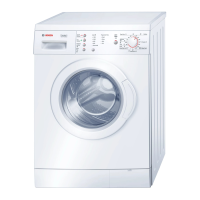
